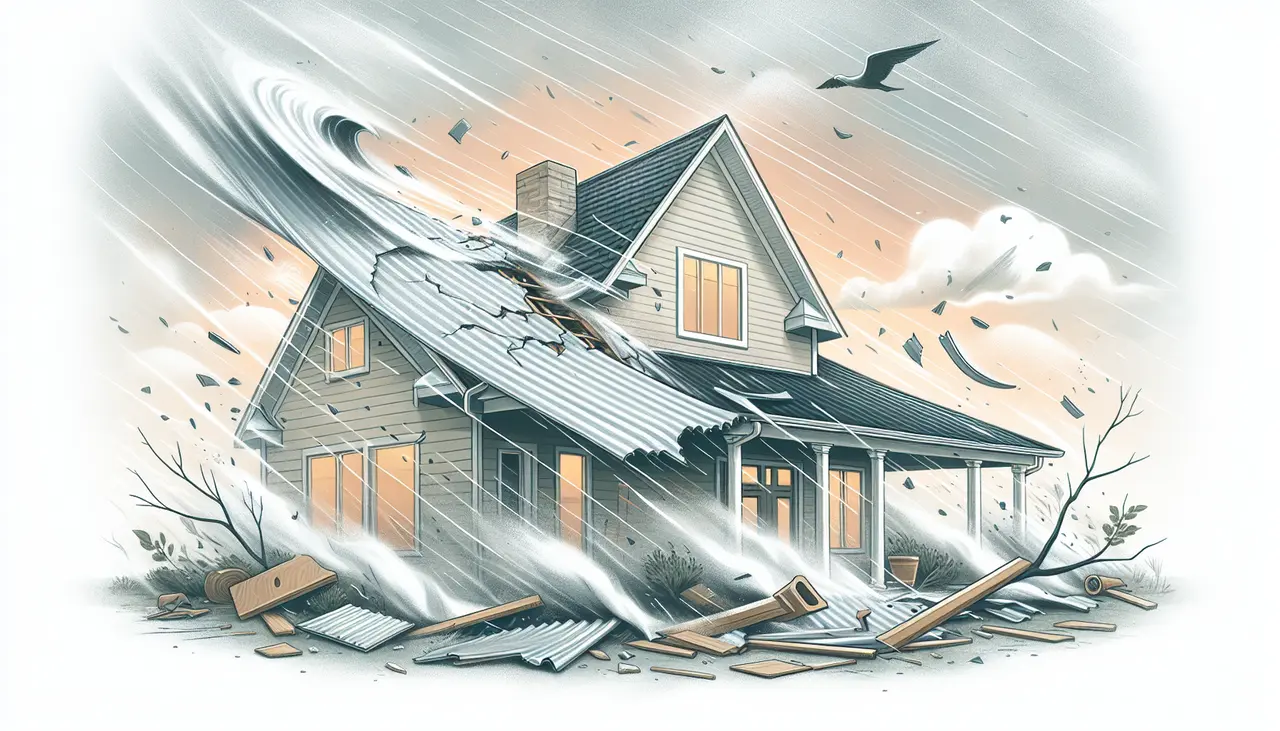Introduction to Elastomeric Roofing
Elastomeric roofing is like a superhero shield for your roof. It’s a liquid coating that’s applied to the roof, setting into a rubbery layer that fights off water, heat, and sun damage. Think of it as a stretchy, durable jacket that helps your roof bounce back from whatever nature throws at it. This type is often used on flat or slightly sloped roofs because its flexibility is perfect for handling temperature changes without cracking. Whether dealing with blazing summers or icy winters, elastomeric roofing keeps your building protected. Its main power is in sealing up leaks and preventing future water damage, making it a smart choice after storm damage. Plus, it reflects sunlight, which can help cool your building and cut down on air conditioning costs. Simple, effective, and cost-efficient, elastomeric roofing might just be the hero your building needs.
Understanding Storm Damage and Roof Vulnerability
Storm damage can wreak havoc on a roof, leaving your home vulnerable to further wear and tear. When a storm hits, it’s not just about the immediate damage; it’s also about how weakened the roof becomes, making it more susceptible to future issues. Roofs can be damaged by high winds peeling off shingles, hail pounding on the surface, or debris flying around and hitting the roof. This kind of damage can create openings for water to seep in, leading to leaks, mold, and structural damage over time. Understanding this vulnerability is key to realizing why choosing the right material for repairs or replacement is crucial after a storm. Elastomeric roofing, known for its durability and resistance to weather extremes, comes into play as a strong candidate. It’s designed to stretch and adapt, providing a protective shield that can significantly reduce the risk of future storm damage. Keeping your roof’s vulnerability in mind is the first step towards making an informed decision on safeguarding your home for years to come.
Elastomeric Roofing: What Is It?
Elastomeric roofing is like a superhero shield for your house. Imagine a paint that’s not just a paint but a tough, durable layer that clings to your roof, protecting it against leaks, weather damage, and more. This roofing material is a liquid coating that is applied over your existing roof. It’s elastic, meaning it can stretch and move with your house during temperature changes without cracking or peeling. This type of roofing is perfect for areas that get hit by storms often. It’s like wrapping your roof in a protective blanket that also reflects heat, keeping your house cooler. So, if you’re tired of dealing with roof damage every time a storm passes, elastomeric roofing might just be the game-changer you’re looking for.
Key Benefits of Choosing Elastomeric Roofing for Storm Protection
Elastomeric roofing, a tough player in the game of storm protection, has key advantages worth looking at. It’s like adding a superhero cape to your roof, making it ready to face whatever the weather throws at it. First off, this roofing type flexes, meaning when temperatures do the tango—soaring high or dipping low—elastomeric roofing moves with them, avoiding cracks and damage. Imagine your roof stretching and bouncing back like elastic. That’s elastomeric roofing for you.
Next, water resistance. This roofing doesn’t just flirt with water; it outright rejects it. So, when heavy rains decide to visit, your roof won’t soak it up. Instead, water slides off, reducing the risk of leaks and water damage. Think of it as your roof wearing an invisible raincoat.
Another bright spot is durability. Elastomeric roofing has a lifespan that outshines many other materials. With proper maintenance, you’re looking at years, even decades, of protection. It’s like investing in a long-term guardian for your home.
Lastly, it’s worth noting the energy savings. By reflecting sunlight instead of absorbing it, elastomeric roofing keeps your home cooler. Your air conditioning won’t have to work overtime, which means lower energy bills. It’s akin to your roof giving your wallet a break during those hot months.
In summary, choosing elastomeric roofing is like picking a versatile, durable, and cost-efficient champion for your home, especially if storm protection is a priority.
How Elastomeric Roofing Stands Against Extreme Weather
Elastomeric roofing is a champ when facing off against extreme weather. Think of it as a superhero cape for your house. This type of roofing applies like paint but acts like a rubber shield, stretching and bouncing back, ready to fight another day. It can handle intense sun, heavy rain, and even hail without breaking a sweat. Here’s the deal: when a storm hits, you want your roof to laugh in the face of danger. Elastomeric coatings can expand with the heat and contract when it cools down, without cracking. This flexibility is a big win because it means fewer leaks and damage over time. Plus, this roofing isn’t just tough; it reflects heat too, keeping your house cooler and saving you some cash on energy bills. In a nutshell, elastomeric roofing is like giving your house a suit of armor against Mother Nature’s mood swings.
The Installation Process of Elastomeric Roofing
The elastomeric roofing installation is straightforward and efficient, making it a strong candidate for post-storm repairs or upgrades. Here’s a simplified rundown: First, the existing roof is cleaned of all debris, dirt, and any moisture – cleanliness is critical. Then, any repairs to the underlying roof structure are undertaken to ensure a solid foundation. Once the roof is prepped, the elastomeric coating application begins. This is typically done using rollers or sprays, covering every inch of the roof surface to create a seamless, water-resistant layer. It’s crucial that the coating is applied evenly and reaches a certain thickness; this ensures maximum durability and protection. The coating then needs time to dry, or “cure,” turning into a tough, rubbery layer that shields the roof from water, UV rays, and minor physical damage. What stands out is this method’s simplicity and the immediate improvement in roof resilience. Post-installation, regular check-ups help maintain its condition, stretching out the life of your roofing system significantly.
Maintenance and Durability of Elastomeric Roof Coatings
Elastomeric roof coatings are known for their durability and easy maintenance, making them a top pick for storm-damaged roofs. These coatings can bounce back from the wear and tear of harsh weather, resisting cracks, leaks, and water damage effectively. Most elastomeric coatings have a life expectancy of about 10 to 20 years, depending on the product quality and application thickness. The best part? Maintaining these roofs is straightforward. You just need to keep them clean and check for any damage periodically. Unlike traditional roofing materials, you won’t have to deal with frequent and costly repairs. Plus, if damage does occur, repairs are typically simple and involve applying more coating on the affected area. This ease of maintenance, combined with strong resistance to weather and aging, places elastomeric coatings high on the list for long-term roofing solutions.
Cost Analysis: Elastomeric Roofing vs. Traditional Options
When your roof takes a hit from a storm, you want a fix that’s both tough and cost-effective. Elastomeric roofing is a solid choice, especially if you’re watching your wallet. Compared to traditional options like asphalt shingles or metal roofing, elastomeric coverings offer a solid bang for your buck. On average, you’re looking at about (1,000 to )3,000 for a professional to apply elastomeric coating over a standard-sized roof. This might sound like a lot upfront, but let’s break it down. Traditional roofing replacements can easily push you into the (5,000 to )10,000 range, depending on the materials you choose and the labor costs in your area. Plus, elastomeric roofing doesn’t just stop with the immediate fix; it’s like adding a super durable layer that resists future storms better than traditional materials. So, while the initial outlay for elastomeric might be less, what you’re really investing in is longer-term savings. You’re not just patching up your roof; you’re upgrading it against future damage. Less repair, less often, means more money stays in your pocket over time.
Real-Life Success Stories: Elastomeric Roofing After Storm Damage
After a nasty storm, the last thing anyone wants is a roofing solution that’s only a short-term fix. Enter elastomeric roofing. It’s more than just a fancy name. People are choosing it for its durability and flexibility. Imagine this: a roof that stretches over your home like a rubber band, shielding it from water and UV damage. Sounds too good, but it’s true. Take John from Florida. Before elastomeric coating, every hurricane season was a nightmare. After? He sleeps soundly, knowing leaks and storm damage won’t be part of his worries. Then there’s Sarah in Texas. Hail used to mean roof repair bills. After switching to elastomeric roofing, she’s noticed hardly any impact, literally. The secret? This roofing can take a beating and bounce back. It’s not just isolated cases. More homeowners share how this roofing option adds years to their roofs’ lives, reducing maintenance costs and stress. So, if longevity and resilience after storm damage matter to you, elastomeric roofing might be worth a look.
Conclusion: Why Elastomeric Roofing Is a Wise Choice for Storm-Prone Areas
If you’re living in an area that gets hit by storms often, picking elastomeric roofing is a smart move. Here’s the deal: elastomeric roofing is like a shield for your house. It’s strong, flexible, and can take a beating from heavy rain, hail, or even strong winds without breaking a sweat. This type of roofing applies like paint but dries to form a rubbery, waterproof coating over your roof. It’s not just about durability; this roofing helps keep your home cooler by reflecting sunlight, which can save you money on cooling costs. Plus, the fact that it’s easy to apply and doesn’t need a whole crew to install means you can get your home back in shape faster after a storm. So, when looking at your options, remember that elastomeric roofing isn’t just another choice; it’s a wise investment for keeping your home safe and reducing future hassle and expense.







